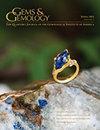Separation of Natural Laboratory-Grown Diamond Using Time-Gated Luminescence Imaging
IF 1.6
3区 地球科学
Q2 MINERALOGY
引用次数: 4
Abstract
GEMS & GEMOLOGY SUMMER 2020 The task of identifying a diamond will typically fall to a diamond appraiser, grader, or gemologist while preparing a grading certificate or appraisal. Whether a diamond is natural or lab-grown is a key factor in its market value and is of paramount importance to the gemologist. Many characteristics can be used to distinguish between natural and synthetic dia mond, but the inherent variability in the properties of natural and synthetic diamond can make such a task difficult. A useful and proven characteristic is the emission of luminescence when a diamond is excited by a source of ultraviolet energy. Typically, a gemologist would utilize an ultraviolet lamp with excitation wavelengths of 365 nm (long-wave ultraviolet, LWUV) or 254 nm (short-wave ultraviolet, SWUV), which correspond to the emission lines of a low-pressure mercury-vapor lamp. In this application, “fluorescence” would be observed during ultraviolet excitation, while “phosphorescence” may be observed when the excitation is removed. The De Beers DiamondView instrument (Spear and Welbourn, 1994; Welbourn et al., 1996) was designed to authenticate natural diamonds and synthetic diamonds. It allows a more sophisticated observation to be made by way of a shorter wavelength excitation of <225 nm corresponding to the primary absorption edge and only exciting around 1-micron depth of material, such that observed luminescence利用时间门控发光成像技术分离实验室生长的天然金刚石
鉴定钻石的任务通常落在钻石估价师、分级师或宝石学家身上,同时准备分级证书或评估。一颗钻石是天然的还是实验室培育的,是决定其市场价值的一个关键因素,对宝石学家来说也是至关重要的。许多特征可以用来区分天然金刚石和合成金刚石,但天然金刚石和合成金刚石性质的内在可变性使这项任务变得困难。一个有用的和被证实的特性是当钻石被紫外线能量源激发时发出的发光。通常,宝石学家会使用激发波长为365纳米(长波紫外线,LWUV)或254纳米(短波紫外线,SWUV)的紫外线灯,这与低压汞蒸气灯的发射线相对应。在此应用中,在紫外线激发时可以观察到“荧光”,而在去除激发时可以观察到“磷光”。De Beers DiamondView仪器(Spear and Welbourn, 1994;Welbourn et al., 1996)设计用于鉴定天然钻石和合成钻石。它允许更复杂的观察,通过较短的波长激发<225 nm对应于主吸收边缘,只激发大约1微米深度的材料,这样观察到发光
本文章由计算机程序翻译,如有差异,请以英文原文为准。
求助全文
约1分钟内获得全文
求助全文
来源期刊

Gems & Gemology
地学-矿物学
CiteScore
2.90
自引率
19.20%
发文量
10
期刊介绍:
G&G publishes original articles on gem materials and research in gemology and related fields. Manuscript topics include, but are not limited to:
Laboratory or field research;
Comprehensive reviews of important topics in the field;
Synthetics, imitations, and treatments;
Trade issues;
Recent discoveries or developments in gemology and related fields (e.g., new instruments or identification techniques, gem minerals for the collector, and lapidary techniques);
Descriptions of notable gem materials and localities;
Jewelry manufacturing arts, historical jewelry, and museum exhibits.
 求助内容:
求助内容: 应助结果提醒方式:
应助结果提醒方式:


